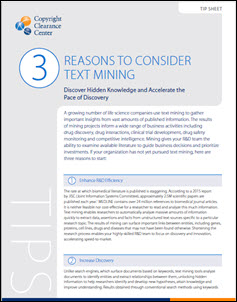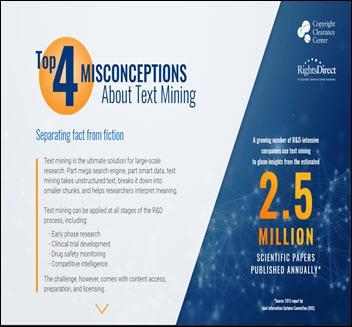A growing number of life science companies use text mining to gather important insights from vast amounts of published information. The results of mining projects inform a wide range of business activities including drug discovery, drug interactions, clinical trial development, drug safety monitoring and competitive intelligence. Download the new Copyright Clearance Center white paper that covers three of the top reasons to consider implementing text mining for life sciences companies.
Search Results for: text mining
Top 4 Misconceptions About Text Mining
Text mining is the ultimate solution for large-scale research. Part mega search engine, part smart data, text mining takes unstructured text, breaks it down into smaller chunks, and helps researchers interpret meaning. Check out the e-book from the Copyright Clearance Center that covers four misconceptions about text mining, as well as the “reality” of each of these situations.
The Downside of Converting Full-Text PDFs to XML for Text Mining
To get the best results from text mining projects, researchers need access to full-text articles. However, when researchers obtain full-text articles through company subscriptions or document delivery, the documents are often provided as PDFs, a suboptimal format for use with text mining software. The burden is then on researchers to convert the PDFs to XML. But that can be inefficient and costly. Read on as Michael Iarrobino, Product Manager at Copyright Clearance Center, explains the pitfalls of converting full-text PDFs to XML for text mining.
The Downside of Converting Full-Text PDFs to XML for Text Mining
One major challenge when converting PDFs to full-text for mining is diminished data integrity. The conversion process can introduce errors (e.g., poor character recognition for uncommon fonts) and often removes tags that indicate sections of the article, such as introduction, conclusion, and materials and methods, making the corpus difficult to mine.
The Advantages of Mining Full-Text Articles over Abstracts
Given their easy accessibility, many researchers use article abstracts to identify a collection of articles for use in text mining. But, while abstracts provide some valuable pieces of information, there are major advantages to taking steps using and mining full-text articles instead. Read on as Michael Iarrobino, Product Manager at Copyright Clearance Center, explains the advantages of mining full-text articles over abstracts.
The Advantages of Mining Full-Text Articles over Abstracts
Text mining enables the rapid review and analysis of large volumes of biomedical literature, giving life science companies valuable insights to drive research and development and inform business decisions. For example, the results of mining projects can provide a greater understanding of the underlying biology behind specific diseases and how they respond to certain drugs, and support the target discovery process.
Data Mining or Bust: How New Data Notebooks Enhance Contact Center Intelligence Aggregation and Analysis to Elevate the Customer Experience
In this contributed article, Tim Eyre, Chief Marketing Officer at Aceyus, discusses how managing the modern contact center involves extrapolating the most up-to-date metrics and data for companies to ensure success and enhance efficiencies. The best way to enhance data transparency is by utilizing dashboards equipped with data notebook capabilities.
How Can Brands Can Leverage Text Analytics for Better Consumer Insights
In this contributed article, Patrícia Osorio, Co-Founder & CMO, Birdie, discusses what is Text Analytics and why you should care about it, and choosing the right text analytics tool and how to get the best out of it.
Data Mining and Predictive Analytics: Things We should Care About
In this contributed article, Vikash Kumar of custom application development company Tatvasoft, presents a high-level view of data mining and predictive analytics technologies as a competitive tool for obtaining business advantage in a dynamic marketplace.
The Untapped Potential in Unstructured Text
In this contributed article, Mary Beth Moore, AI and Language Analytics Strategist at SAS, suggests that you look at your organization and consider the unstructured text you gather and the possible revelations it may hold. That data reflects the voices of those you serve and holds the potential to help you deliver better experiences, improve quality of care and enrich human engagement. There are powerful stories to be told from your unstructured text data.











